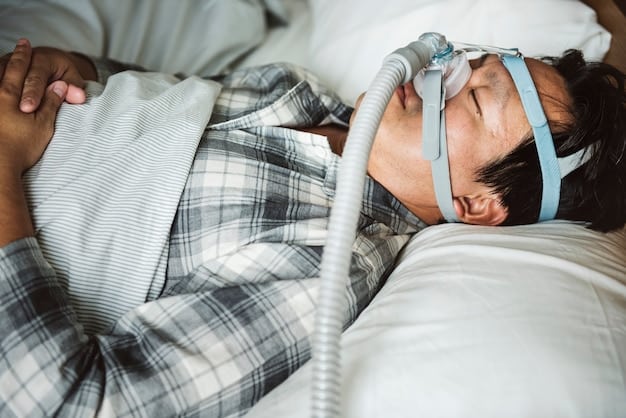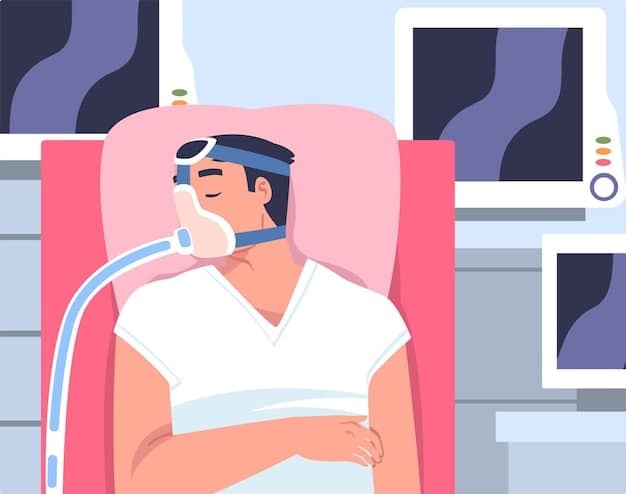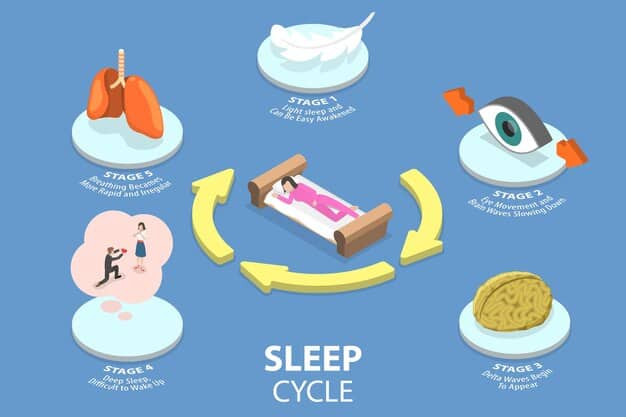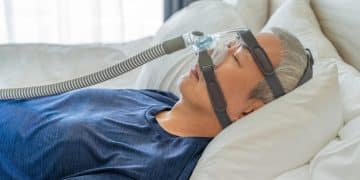Sleep Apnea & ED: Understanding the Link and What to Do

The link between sleep apnea and erectile dysfunction is significant, involving reduced oxygen levels and hormonal imbalances that can negatively impact sexual function, highlighting the importance of diagnosing and treating sleep apnea for overall health and well-being.
Do you struggle with erectile dysfunction (ED) and also find yourself constantly tired, even after a full night’s sleep? There might be a connection you haven’t considered: the link between sleep apnea and erectile dysfunction: what you need to know. Understanding this connection is the first step towards addressing both issues and improving your overall quality of life.
Understanding Sleep Apnea
Sleep apnea is a common sleep disorder where your breathing repeatedly stops and starts during sleep. This interruption in breathing can lead to a variety of health problems, extending far beyond just feeling tired. Recognizing the symptoms and understanding the underlying mechanisms is crucial for effective management.
Types of Sleep Apnea
There are three main types of sleep apnea, each with its own distinct cause. Obstructive sleep apnea (OSA) is the most common type, followed by central sleep apnea (CSA), and then complex sleep apnea, which is a combination of both.
- Obstructive Sleep Apnea (OSA): Caused by a physical blockage of the airway, usually by the soft tissues in the back of the throat collapsing during sleep. This is often associated with obesity, large neck circumference, and certain anatomical features.
- Central Sleep Apnea (CSA): Occurs when the brain doesn’t send proper signals to the muscles that control breathing. This is less common and often related to underlying medical conditions such as heart failure or neurological disorders.
- Complex Sleep Apnea: A combination of both OSA and CSA, presenting with both physical obstruction and neurological signaling issues. Diagnosis and treatment can be more complex due to the mixed nature of the disorder.
Common Symptoms of Sleep Apnea
Recognizing the symptoms of sleep apnea is the first step toward getting diagnosed and treated. Symptoms can vary in severity and might be more noticeable to a bed partner than to the individual experiencing them.

- Loud Snoring: Frequent and disruptive snoring is a hallmark symptom of OSA, often punctuated by pauses and gasps for air.
- Daytime Sleepiness: Excessive daytime fatigue, even after a full night’s sleep, is a common indicator of poor sleep quality due to interrupted breathing.
- Morning Headaches: Frequent headaches upon waking can be a result of the body’s decreased oxygen levels during sleep.
- Difficulty Concentrating: Cognitive impairment, including problems with memory and focus, can occur due to sleep fragmentation and oxygen deprivation.
In summary, sleep apnea is a multifaceted disorder that disrupts normal breathing patterns during sleep. Understanding its types and recognizing common symptoms are essential steps toward diagnosis and treatment, ultimately improving overall health and quality of life.
Erectile Dysfunction: An Overview
Erectile dysfunction (ED) is defined as the inability to achieve or maintain an erection firm enough for satisfactory sexual intercourse. It’s a widespread condition that affects men of all ages, though it becomes more common with increasing age. Understanding the causes and available treatments can help men address this sensitive issue effectively.
Common Causes of Erectile Dysfunction
ED can result from a variety of physical and psychological factors. Identifying the underlying cause is critical for determining the most appropriate course of treatment.
- Physical Conditions: Conditions like heart disease, diabetes, high blood pressure, and high cholesterol can damage blood vessels and nerves, impairing erectile function.
- Psychological Factors: Stress, anxiety, depression, and relationship problems can significantly contribute to ED. These factors can interfere with the brain signals required to achieve an erection.
- Lifestyle Factors: Smoking, excessive alcohol consumption, and drug use can negatively impact blood flow and nerve function, increasing the risk of ED.
Treatment Options for Erectile Dysfunction
Fortunately, there are various effective treatment options available for ED, ranging from lifestyle changes to medical interventions. Consulting with a healthcare provider is essential to determine the best approach based on individual needs and circumstances.
Treatment options for ED involves several things, as listed below:
- Lifestyle Modifications: Adopting a healthy lifestyle, including quitting smoking, reducing alcohol intake, maintaining a healthy weight, and exercising regularly, can improve erectile function.
- Medications: Oral medications like sildenafil (Viagra), tadalafil (Cialis), and vardenafil (Levitra) can enhance blood flow to the penis, facilitating erections. However, these medications require a prescription and may have potential side effects.
- Therapy: Addressing psychological factors through counseling or therapy can be beneficial, particularly when stress, anxiety, or relationship issues are contributing to ED.
In conclusion, erectile dysfunction is a prevalent condition with diverse causes and a range of effective treatment options. By understanding the underlying factors and seeking appropriate medical care, men can overcome ED and improve their sexual health and overall well-being.
The Connection Between Sleep Apnea and ED
The link between sleep apnea and erectile dysfunction is increasingly recognized as a significant factor in men’s sexual health. The physiological changes and hormonal imbalances caused by sleep apnea can directly impact erectile function.

How Sleep Apnea Contributes to ED
Sleep apnea can contribute to ED through several interconnected mechanisms. Understanding these physiological pathways helps to explain the strong correlation between the two conditions.
- Reduced Oxygen Levels: Sleep apnea causes intermittent drops in blood oxygen levels (hypoxia), which can damage the blood vessels and nerves necessary for erectile function.
- Hormonal Imbalances: Sleep apnea disrupts hormone production, including testosterone, which is crucial for libido and erectile function. Lower testosterone levels can lead to decreased sexual desire and difficulty achieving erections.
- Increased Blood Pressure: The repeated arousals from sleep during sleep apnea can elevate blood pressure, increasing the risk of cardiovascular disease, which is a known risk factor for ED.
Research Findings on Sleep Apnea and ED
Numerous studies have demonstrated a strong association between sleep apnea and ED. These research findings support the importance of screening and treating sleep apnea in men experiencing erectile dysfunction.
According to one study:
- Men with sleep apnea are significantly more likely to experience ED compared to those without the condition.
- Treating sleep apnea with continuous positive airway pressure (CPAP) therapy can improve erectile function in some men.
- The severity of sleep apnea is often correlated with the severity of ED, suggesting a dose-response relationship.
In summary, the relationship between sleep apnea and ED is complex and multifaceted, involving reduced oxygen levels, hormonal imbalances, and increased blood pressure. Research consistently supports the link between these conditions, highlighting the importance of addressing sleep apnea for better sexual health.
Diagnosing Sleep Apnea
Diagnosing sleep apnea involves a thorough evaluation of your symptoms, a physical examination, and often a sleep study to monitor your breathing patterns during sleep. Early diagnosis is crucial for preventing long-term health complications.
Methods for Diagnosing Sleep Apnea
Several methods are used to diagnose sleep apnea, each providing valuable information about your sleep patterns and breathing function.
- Polysomnography (Sleep Study): This overnight test, conducted in a sleep lab, monitors brain waves, eye movements, heart rate, breathing patterns, and oxygen levels during sleep. It is considered the gold standard for diagnosing sleep apnea.
- Home Sleep Apnea Test (HSAT): This portable device allows you to monitor your breathing patterns at home. It measures oxygen levels, heart rate, and airflow. HSATs are convenient but may not be as comprehensive as polysomnography.
The best option is to consult with a healthcare professional who can assess your specific needs and recommend the most appropriate diagnostic approach for possible the link between sleep apnea and erectile dysfunction: what you need to know.
Treating Sleep Apnea
Treating sleep apnea can significantly improve your sleep quality, reduce your risk of associated health problems, and potentially alleviate erectile dysfunction. Various treatment options are available, tailored to the severity of your condition and individual needs.
Treatment Options for Sleep Apnea
There is no one-size-fits-all treatment for sleep apnea; the best approach depends on the type and severity of the condition.
- Continuous Positive Airway Pressure (CPAP) Therapy: CPAP is the most common and effective treatment for OSA. It involves wearing a mask over your nose and mouth while you sleep, delivering a constant flow of air that keeps your airway open.
- Oral Appliances: These custom-fitted mouthpieces help keep your airway open by repositioning your jaw or tongue. They are often used for mild to moderate OSA.
- Lifestyle Changes: Losing weight, avoiding alcohol and sedatives before bedtime, and sleeping on your side can help reduce the severity of sleep apnea.
- Surgery: In some cases, surgery may be necessary to remove or reposition tissues in the throat that are obstructing the airway.
The benefits of treating sleep apnea should also be considered. Some include improved sleep, improved sexual performance and reduced risk of heart related conditions.
Lifestyle Changes for Better Sleep and Sexual Health
Adopting certain lifestyle changes can significantly improve both your sleep quality and sexual function. These changes focus on promoting overall health and addressing factors that can contribute to both sleep apnea and ED.
Recommendations for Lifestyle Changes
Integrating these lifestyle recommendations into your routine can lead to significant improvements in your sleep and sexual health.
- Maintain a Healthy Weight: Obesity is a significant risk factor for both sleep apnea and ED. Losing weight through diet and exercise can reduce airway obstruction and improve blood flow.
- Exercise Regularly: Regular physical activity can improve cardiovascular health, reduce stress, and enhance libido. Aim for at least 30 minutes of moderate-intensity exercise most days of the week.
- Quit Smoking: Smoking damages blood vessels and impairs blood flow, increasing the risk of both ED and sleep apnea. Quitting smoking can significantly improve your overall health and sexual function.
- Limit Alcohol and Sedatives: Alcohol and sedatives can relax the throat muscles, exacerbating sleep apnea. They can also negatively impact erectile function. Avoid these substances before bedtime.
| Key Point | Brief Description |
|---|---|
| 😴 Sleep Apnea | Breathing stops and starts during sleep, affecting oxygen levels. |
| 💔 Erectile Dysfunction (ED) | Inability to achieve or maintain an erection. |
| 🔗 The Link | Sleep apnea can contribute to ED through reduced oxygen and hormonal imbalance. |
| 🛠️ Action | Diagnose sleep apnea, adopt lifestyle changes for better sexual health. |
Frequently Asked Questions
▼
Yes, treating sleep apnea, especially with CPAP therapy, can improve erectile function by addressing the underlying issues of reduced oxygen levels and hormonal imbalances.
▼
Common risk factors include obesity, age, diabetes, high blood pressure, smoking, and excessive alcohol consumption. These factors impact both sleep and sexual health.
▼
Sleep apnea is typically diagnosed with a polysomnography (sleep study) performed in a lab, or sometimes with a home sleep apnea test to measure breathing patterns.
▼
Yes, maintaining a healthy weight, exercising regularly, quitting smoking, and limiting alcohol can improve both sleep apnea and erectile dysfunction symptoms.
▼
You should consult a doctor if you experience symptoms of sleep apnea, such as loud snoring and daytime sleepiness, or if you have persistent erectile dysfunction issues.
Conclusion
Understanding the link between sleep apnea and erectile dysfunction: what you need to know is essential for addressing both conditions effectively. By diagnosing and treating sleep apnea, and adopting healthy lifestyle changes, individuals can improve their sleep quality, sexual health, and overall well-being.





